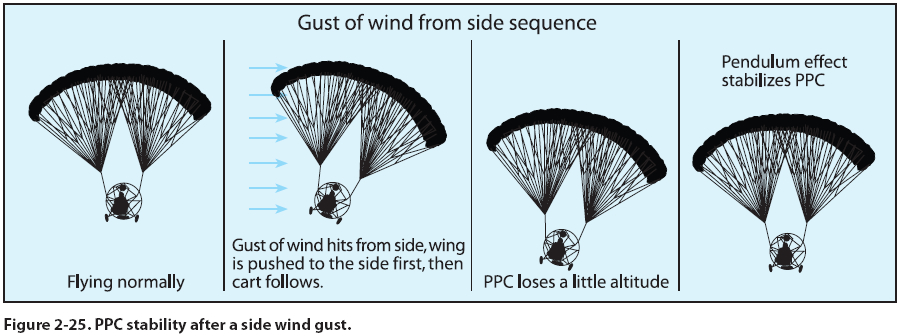Chapter 2 - Aerodynamics of Flight
Stability
A stable aircraft is one that will routinely return to its
original attitude after it has been disturbed from this
condition; usually this means returning to straightand-
level flight after encountering turbulence that disrupts
a normal flightpath. The more stable the aircraft,
the easier it is to return to a straight and level position.
The natural tendency of the pendulum — the PPC cart
hanging under the wing — is to return to its original
centered position under the wing. The pendulum design
gives the PPC airborne positive dynamic stability
and positive static stability for roll and pitch because
the weight of the pendulum wants to return the PPC
to level stabilized flight. No matter what maneuver
within the POH limitations the PPC is put through
(regardless of whether it is pilot induced or turbulence
created), as soon as the disruptive force stops, the aircraft
is designed to return to a stabilized flight condition,
with virtually no pilot input. Figure 2-25 shows
the movements of the PPC as it auto-corrects from a
side gust of wind.

PPC Angle of Attack Characteristics
Normal Flying Conditions
For all practical purposes, the wing’s lift in a steady
state normal climb is the same as it is in a steady level
flight at the same airspeed. Though the flightpath has
changed when the climb has been established, the angle
of attack of the wing with respect to the inclined
flightpath reverts to practically the same value, as
does the lift. The angle of attack remains relatively
constant for constant weights during stabilized flight
for glide, level cruise or climb. However, wind gusts,
flying in turbulence, quick uncoordinated flight (as
covered later), or aerobatic maneuvers can change the
PPC angle of attack. PPC limitations in the POH are
specifically written to avoid any maneuver that would
temporarily get the PPC into a situation of too high
or too low an angle of attack. The PPC is specifically
designed to fly at an angle of attack to avoid stalls
(resulting from too high an angle of attack), and avoid
wing collapses (resulting from too low an angle of attack).
Each manufacturer specifically determines the
limitations so a proper angle of attack is maintained
throughout the flight operation range.
The basic design of the powered parachute is to fly
at a relatively constant speed which results in a constant
angle of attack. However, angle of attack can
change just as with any aircraft as when a gust of wind changes the direction the air is hitting the airfoil. [Figure
2-26]

The pilot can add weight or increase loads which may
also increase the angle of attack slightly.
|

